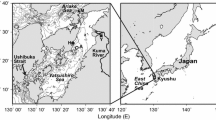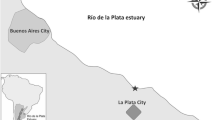Abstract
Toxic cyanobacterial blooms have occurred in the near-shore waters of the North Basin of Lake Biwa, Japan, since 1994, and have been attributed to deterioration of water quality in the enriched littoral zone of the lake. From 1997 onwards, the bloom-forming cyanobacteria have been observed with increasing frequency in the deep offshore waters of the North Basin. In the present study, we examined the mechanisms responsible for these bloom populations in the main body of the lake. Specifically, we addressed the hypothesis that buoyant, nutrient-replete colonies of cyanobacteria are generated inshore, are advected offshore by large-scale horizontal transport processes, and subsequently accumulate in the downwelling center of large surface gyres that characterize the overall circulation pattern in the epilimnion of the North Basin. Diel variations of Microcystis biomass at the center and the edge of the Lake Biwa gyre were monitored at 6-h intervals on August 23–24, 2000, and the horizontal distribution of buoyant Microcystis was determined on October 6. The hydrodynamic structure of the first gyre was determined over the preceding 2 days by an on-board Acoustic Doppler Current Profiler (ADCP). The gyre was characterized by a counterclockwise horizontal current that could potentially advect material large distances offshore, a downwelling current near the center of the gyre, and an upwelling current at the edge of the gyre, caused by the radial pressure gradients. The biomass of Microcystis near the water surface was greater at the center than at the edge of the gyre, and the biomass at 5 m depth at the edge of the gyre was greater than that at the water surface or at the thermocline near the edge of the gyre. The results are consistent with the gyre-Microcystis hypothesis, and show the potential for accumulation of large concentrations of cyanobacteria in deep offshore lake environments that are normally considered unsuitable for cyanobacterial blooms.
Similar content being viewed by others
Author information
Authors and Affiliations
Additional information
Received: July 16, 2001 / Accepted: March 6, 2002
Rights and permissions
About this article
Cite this article
Ishikawa, K., Kumagai, M., Vincent, W. et al. Transport and accumulation of bloom-forming cyanobacteria in a large, mid-latitude lake: the gyre-Microcystis hypothesis. Limnology 3, 87–96 (2002). https://doi.org/10.1007/s102010200010
Issue Date:
DOI: https://doi.org/10.1007/s102010200010




